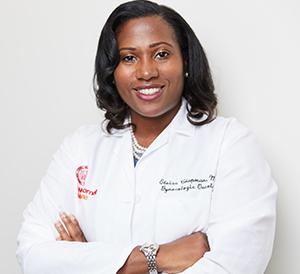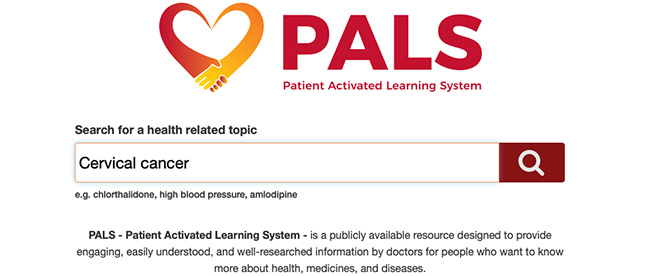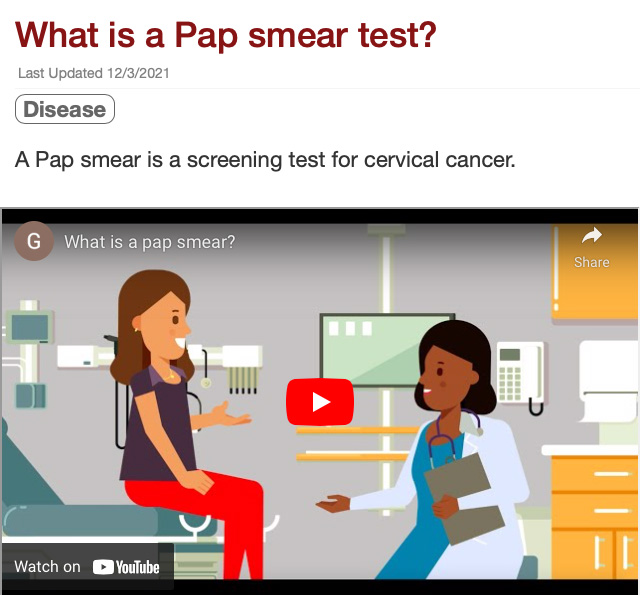Cervical Cancer: How Web-Based Education is Addressing Healthcare Disparities
Eloise Chapman-Davis, MD, is Director of Gynecologic Oncology in the Department of Obstetrics and Gynecology at NewYork-Presbyterian/Weill Cornell Medical Center and Associate Professor of Obstetrics and Gynecology at Weill Cornell Medicine. In her practice, Dr. Chapman-Davis cares for patients representing the full spectrum of gynecologic cancers – from those with preventable and treatable disease to patients with malignancies that continue to evade the current therapies science has to offer. The breadth of her experience in the field has provided her with an informed perspective on disparities in gynecologic cancer care.

Dr. Eloise Chapman-Davis
As such, Dr. Chapman-Davis is actively engaged in clinical and translational research on approaches to improve gynecologic cancer outcomes seen through the prism of healthcare disparities. “While my research highlights disparities in health care, I am particularly focused on the factors that lead to differences in outcomes and how to address these factors,” says Dr. Chapman-Davis. “One of my major concerns is with cervical cancer prevention because this is the one cancer for which there is an excellent screening mechanism, namely HPV testing, and, even more importantly, vaccines that can prevent infection with disease-causing HPV. In fact, cervical cancer is the easiest gynecologic cancer to prevent through screening and early vaccination.”
Cervical Cancer Disparities in the United States
Higher rates of cervical cancer are seen in:
- Women without access to care
- Black and Hispanic women
- Women living in non-metropolitan areas
- Women with lower socioeconomic status
- Women who have never been screened or have not been screened in the past five years
“It is known that in 60 to 80 percent of cervical cancers, the cause is related to various types of high-risk human papillomavirus,” continues Dr. Chapman-Davis. “Yet the United States still has a high rate of cervical cancer, which should not be the case in a developed country where there is access to both screening and vaccination. We also know that patients of racial/ethnic minorities are more likely to present with advanced stage cervical cancer and also more likely to die than other ethnicities. The gap is also widening among older women who are ineligible for HPV vaccination, under-screened, or aged out of screening. So when we talk about disparities in cervical cancer and prevention, one focus is on addressing the low HPV vaccination rates in these populations and the other is addressing why people who do undergo screening with Pap smears are lost to follow-up.”
Dr. Chapman-Davis established a strategy that involves analyzing follow-up rates for colposcopy and devising an approach that could galvanize patients to undergo the next step in screening. The goal is to prevent patients from developing cervical cancer or making the diagnosis early enough to effect a cure.
Initial screening is less of a concern – over 81 percent of minority women have undergone cytological screening in the last three years. The more major challenge is faced when a Pap smear comes back abnormal. Many patients do not proceed to colposcopy, biopsy, or removal of the abnormal tissue and, therefore, are almost guaranteed to develop cervical cancer. The questions that Dr. Chapman-Davis is tackling are why and what do we do about it.
With this in mind, Dr. Chapman-Davis established a strategy that involves analyzing follow-up rates for colposcopy and devising an approach that could galvanize patients to undergo the next step in screening. The goal is to prevent patients from developing cervical cancer or making the diagnosis early enough to effect a cure.
PALS: Necessity is the Mother of Intervention
Dr. Chapman-Davis and her colleagues devised a two-pronged study with a primary goal to develop and test an intervention designed to improve knowledge and follow-up among underserved women with abnormal Pap smears. They collaborated with General Internal Medicine founders of the PALS, following a patient-centered approach. They first conducted interviews with 18 patients in their practice to identify knowledge gaps regarding Pap smears, treatments, and barriers that impede women with abnormal Pap smears from proceeding to the next stage of care that could save their lives.
“We interviewed several underserved women in various racial/ethnic groups from our own underserved clinic population to find out why they were not following up after learning they had an abnormal Pap smear,” notes Dr. Chapman-Davis. “We found that the reason was largely a lack of understanding about their results and subsequent care. Some patients were concerned about what the colposcopy would entail, and others did not understand that the results could mean they are at risk for developing cervical cancer.”
Information from the interviews was used by the team to create an intervention based in the Patient Activated Learning System (PALS) – a series of 10 videos that address issues raised by their patients about cervical cancer, including:
- What is HPV?
- What is a Pap smear test?
- What do I do if my Pap smear is abnormal?
- What is a colposcopy?
- What happens if the colposcopy is abnormal?



The PALS can be used on a computer or a smartphone. Since the launch of Dr. Chapman-Davis’ PALS videos in January 2022, the video on a Pap smear test has had 6,000 views; the video on colposcopy has had more than 10,800 views.
The PALS concept has been developed since 2015 by a team led by Monika M. Safford, MD, a clinician-investigator at Weill Cornell Medicine with particular research expertise in disease prevention and healthcare disparities. This publicly available resource provides engaging, easily understood, and well-researched information by doctors for people who want to know more about health, medicines, and diseases. The PALS content has been viewed in over 200 countries by more than 400,000 unique users.
The approach was very well suited for Dr. Chapman-Davis’ goal. After creation of the PALS intervention for cervical cancer, she and her colleagues conducted a pilot study in 60 patients in both the clinic population and physician practice offices to evaluate the program’s feasibility, acceptability, and usability by introducing the technology at the time of patients’ visits and integrating PALS into text message reminders.
“We would send a link to patients ahead or at the time of their appointments and were able to track if they reviewed the videos,” says Dr. Chapman-Davis, who co-authored the PALS content for cervical cancer. “We surveyed them on whether they liked the videos, if they helped them to better understand their results and future care that was needed, and if it affected their intent to follow up. The feedback was very good in terms of the feasibility and acceptability of this video intervention.”
Promoting the HPV Vaccine with PALS
The HPV vaccine is approved for patients ages 9 to 26, and pediatricians will generally begin a conversation with their 11- to 15-year-old patients. This led Dr. Chapman-Davis and her team to collaborate with their pediatric colleagues who specialize in adolescent medicine to promote awareness of the importance of the HPV vaccine. “We provided a similar PALS intervention to the cervical cancer program, creating videos on the HPV vaccine, including information such as the best age for vaccination and potential side effects,” says Dr. Chapman-Davis. “Our content was derived from feedback from patients and parents on their concerns related to the vaccine. We tried to address not only their concerns, but also the misinformation that is circulating about this vaccination.”
The team also piloted the vaccination intervention in over 100 patients with both parents and children reviewing the videos. The PALS approach to vaccine education was also very well received with regard to promoting knowledge uptake as well as an increase in intent to vaccinate. Based on this feedback, Dr. Chapman-Davis and her colleagues have moved forward to a larger trial. The program will also soon be available in Spanish and Cantonese.
Each of the pilot studies was supported by Weill Cornell Medicine’s Dean's Diversity Award and Primary Care Innovation Award, as well as a grant from the Cornell Center for Health Equity. “These grants have enabled us to collect the pilot data needed to move forward on larger scale studies with a goal to understand that healthcare disparities can traverse different populations based on racial/ethnic minorities, socioeconomic status, and primary language spoken,” says Dr. Chapman-Davis. “We are trying to address each of these in a way that will help decrease cervical cancer care disparities.”
Since PALS for cervical cancer first went live in January 2022, its usage in the first six months has been phenomenal, including 6,000 views of the video on What is a Pap smear test? and over 10,800 views of What is a colposcopy? The research team is currently reviewing this data with a plan to institute PALS on a larger scale throughout NewYork-Presbyterian’s hospital system. The randomized trial will evaluate if providing PALS ahead of appointments helps patients with knowledge and pursuing vaccination and follow-up care.
“We envision that through New York-Presbyterian’s Epic medical record system, we can engage other gynecologists, pediatricians, primary care physicians, and clinical colleagues in recommending PALS,” says Dr. Chapman-Davis. “We would also like to be able to automatically have the EMR system flag an abnormal Pap test as well as those who are eligible for the HPV vaccine. Providing a link to PALS in the EMR would facilitate patient access to this information before their appointments and make for a more productive visit between doctor and patient.”
For More Information
Dr. Eloise Chapman-Davis
NewYork-Presbyterian
Advances in Women's Health (OBGYN)
Read more about our latest clinical advances.


